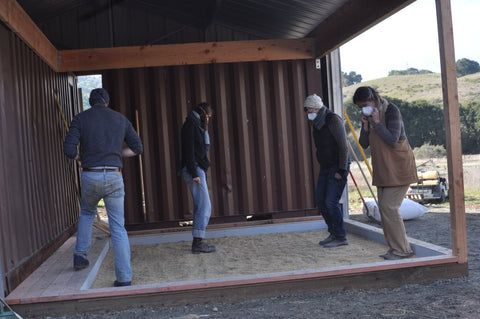This weekend, I traveled to Marin County, just north of here, to meet with master indigo dyer, Rowland Ricketts. He taught us about the particular species of indigo plant he grows, the process he uses to compost his indigo, thus making it into a dye, and how to create a fermentation vat to use the indigo as a dye. One of the important points Rowland makes is that the cultivation of the indigo plant and the creation of indigo vats is mainly done in parts of the world with a sub-tropical or tropical climate. As indigo dyers in the U.S. / Western Hemisphere, our climate is not as consistently humid and hot. Also, as in many forms of textile production, people who make textiles that we honor and would like to preserve, use materials inherent to their lives and culture. So we must look in our own communities, and world around us, to see if and what we can gather to accomplish the same means. This was definitely part of our exploration as we had to use some materials a bit different than in Japan, specifically the clay.
In this first part of my series on Rowland's style of indigo cultivation and dyeing, I am going to describe the root material, indigo, and give you an overall sense of the process.
First, we take the indigo plant, which has many different species. The particular species Roland grows is Polygonum tinctorium. This species has responded favorably to our climate. Then the indigo is harvested (possible 2-3 times in a single season), and left out to dry.
In the meantime, a structure must be built to house the composting portion of the indigo process. This is what we started to construct on Tuesday.

The Nedoko built by John of the Marin Carbon Project .

Leveling of base floor: rock.

Applying a layer of sand.

Rowland demonstrates the Japanese method of tamping.

Power in numbers, we tamp together using our feet.

Rowland tests for balance and accuracy.

Next layer: rice hulls.

The tamping continues.

More sand is carefully added - don't disturb the rice hulls.

Rowland adds the first of many bags of clay.

And we tamp.

The floor is finally level. Rowland wets the surface.
The next day, Rowland and Rebecca continued to work. The clay floor needs to have a center which is slightly higher than the edges.
Once the floor is finished and set, dried indigo leaves (440 lbs) will be placed upon the floor and covered with straw mats. The indigo will begin decomposing. The process in which we layered the materials will allow the indigo to breathe just enough so it does not rot. The rice hulls are warm and aid to the composting process. After 100 days, the composted indigo will be ready to be added to the dyepot. In indigo dyeing, for the indigo to adhere to the fiber, the oxygen must be removed from the pot (vat). Currently, we do this at Verb chemically (through the addition of either thiourea dioxide or sodium hydro-sulphite), we would like to make the move towards doing indigo without these chemicals. In order to do this, we must start a fermentation vat in which we raise bacteria which will eat the oxygen molecule. The superb thing about the compost indigo is that it contains the bacteria necessary to reduce the indigo vat. If able to use composted indigo, we would be able to change at least a portion of how we are currently dyeing with indigo. This new process would allow us to have a healthier way - to both us and the environment. And, it would allow us to support indigo farmers, such as Rowland and Rebecca. In the meantime, we are growing Polygonum tinctorium at Verb. If you would like to get involved get in touch, we could use your help with the growing.
Part 2 of this article will be about winnowing indigo seed.
Hopefully, there will be a part 3 to this story, in which we start either processing our own indigo or begin the process of creating our fermentation vats.
